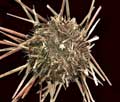The Echinoid Directory
Contributed by Simon Coppard, September 2006
Coelopleurus (Keraiophorus) floridanus A. Agassiz, 1872, p. 102
| Diagnostic Features |
|
|---|---|
| Distribution | West Indies, East coast of America as far as Cape Hatteras |
| Classification and/or Status | Arbacioida, Arbaciidae, Coelopleurus |
| Remarks | This species is similar to C. interruptus and C. vittatus in the colour and markings on the naked median regions of the interambulacra. However, in these species the naked median regions are bordered by white (not red), primary spines are almost straight, and the aboral ophicephalous pedicellariae have constricted valves. Agassiz, A. 1872-1874. Revision of the Echini. Memoirs of the Museum of Comparative Zoology at Harvard College III: pt. 1-2: i-xii, 1-378, pls. 1-49 (1872); pt. 3: 379-628 +1, pls. 50-77 (1873); pt. 4: 629-762, pls. 78-94 (1874). |

